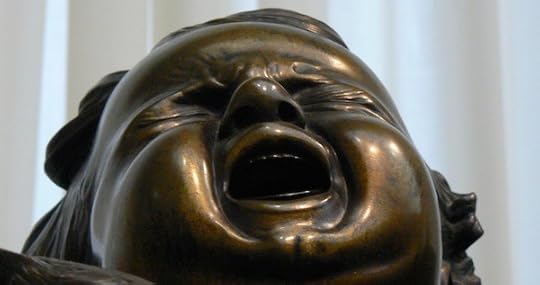Carl Zimmer's Blog, page 61
July 4, 2011
Fourth-of-July Secrets-in-the-Attic Book Sale!
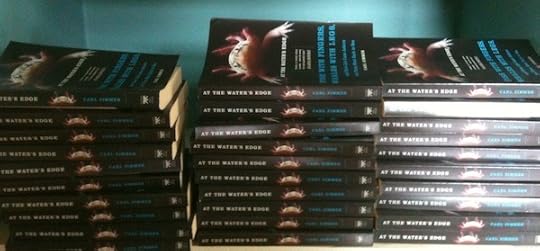 Having just returned from a ten-day family reunion road trip, I discovered a surprise in our attic: several extra boxes of my first book, At the Water's Edge. You may recall that I put a bunch of autographed copies of this book on sale in my Amazon store to clear them out in advance of my office getting ripped apart. Well, the ripping-apart is now just days away, and now I have eighty more copies to get out of this house. (This photo shows just a selection.)
Having just returned from a ten-day family reunion road trip, I discovered a surprise in our attic: several extra boxes of my first book, At the Water's Edge. You may recall that I put a bunch of autographed copies of this book on sale in my Amazon store to clear them out in advance of my office getting ripped apart. Well, the ripping-apart is now just days away, and now I have eighty more copies to get out of this house. (This photo shows just a selection.)
So–help! For the next week, you can get an autographed copy for six bucks. Order it here.
"What?" you say. "Someone get this man to a hospital. The tail pipe of his station wagon must have been inserted directly into his nostrils for his entire road trip, robbing him of all common sense!" Well, my carbon monoxide poisoning is your good fortune–get your copy now. The sledgehammers are breaking through very soon.
If you haven't heard about the book, it's about how major transitions in evolution take place–and how scientists reconstruct them. Publishers Weekly called it "an entertaining history of ideas written ...
June 30, 2011
De-discovery round-up (plus a correction)
It's been very gratifying to listen to the conversation that's been triggered by my essay in this Sunday's New York Times on scientific self-correction. Here, for example, is an essay on the nature of errors in science by physicist Marcelo Gleiser at National Public Radio. Cognitive scientist Jon Brock muses on how to get null results published.
I also got an email from Eliot Smith, the editor of the Journal of Personality and Social Psychology who accepted the controversial clairvoyance paper I described in my essay. I wrote that three teams of scientists failed to replicate the results and that all three studies were rejected by the journal because they don't accept simple replication studies.
Mr. Zimmer
Your recent Times column stated the following:
Three teams of scientists promptly tried to replicate his [Bem's] results. All three teams failed. All three teams wrote up their results and submitted them to The Journal of Personality and Social Psychology. And all three teams were rejected — but not because their results were flawed. As the journal's editor, Eliot Smith, explained to The Psychologist, a British publication, the journal has a longstanding policy of not publishing replication studies. "This policy is not new ...

June 27, 2011
Discovering my microbiome: "You, my friend, are a wonderland"
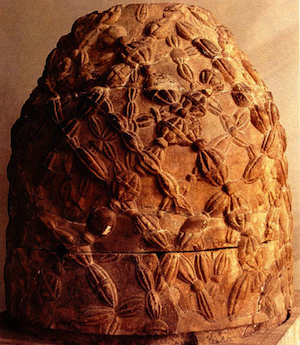 Some people get a thrill from getting their genome sequenced and poring through the details of their genes. I'm a bit off-kilter, I guess, because I'm more curious about the genomes of the things living in my belly button. And let me tell you: it's a jungle in there.
Some people get a thrill from getting their genome sequenced and poring through the details of their genes. I'm a bit off-kilter, I guess, because I'm more curious about the genomes of the things living in my belly button. And let me tell you: it's a jungle in there.
I first became curious about my navel in January. I was in Durham, North Carolina, to attend a meeting, and as I walked out of a conference room I noticed a cluster of people in the lobby handing out swabs. They were asking volunteers to stick the swabs in their belly button for the sake of science. Our bodies are covered with microbes, and scientists are discovering weirdly complex patterns to their biodiversity. From fingers to elbows to chin to forehead, different regions of our skin are dominated by different combinations of species. But the bellybutton remained terra incognita.
I happily donated my microbiome to the study, which is being conducted by Jiri Hulcr and Andrea Lucky, two post-doctoral researchers in the laboratory of Rob Dunn at North Carolina State University. After a few weeks, Hulcr sent me a photo ...
Dediscovery: My new essay for a new section of the New York Times
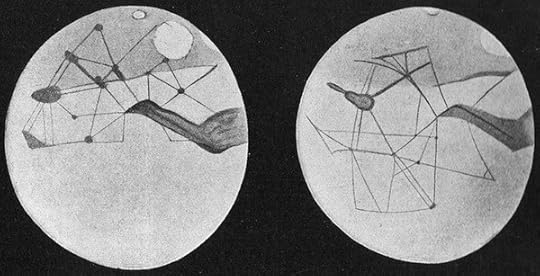 In the late 1800s, prominent astronomers declared that Mars was criss-crossed by canals–evidence, they declared, of an advanced civilization. But in the early 1900s, astronomers gazed through more powerful telescopes and discovered that the canals were mirages.
In the late 1800s, prominent astronomers declared that Mars was criss-crossed by canals–evidence, they declared, of an advanced civilization. But in the early 1900s, astronomers gazed through more powerful telescopes and discovered that the canals were mirages.
The astronomer Percival Lowell, who had become the leading champion of the canals, scoffed at the new findings He declared that the criticism came "solely from those who without experience find it hard to believe or from lack of suitable conditions find it impossible to see."
Although the new evidence led many astronomers to abandon Lowell's position, he never retracted his claim. It wasn't until five decades after his death in 1916 that space probes finally went into orbit around Mars and sent back close-up pictures of a canal-free Red Planet.
I've always been fascinated by the way science casts aside bad ideas. For most of us, it's easy to assume that science shakes them off quickly, but the truth is that it can take quite a while for the process to play out. Recently I was invited to contribute a piece to the new "Sunday Review" section of the New York Times, which ...
June 21, 2011
Viral radio: A talk about viruses on KUSP in Santa Cruz
You can listen here to a fun talk I had with Robert Pollie at KUSP in Santa Cruz on my recent visit to the Bay. We spoke for an hour about A Planet of Viruses, and so we had the luxury of delving into the fun questions, like whether viruses are alive. Check it out.

A Beautiful Web of Poison Extends A New Strand
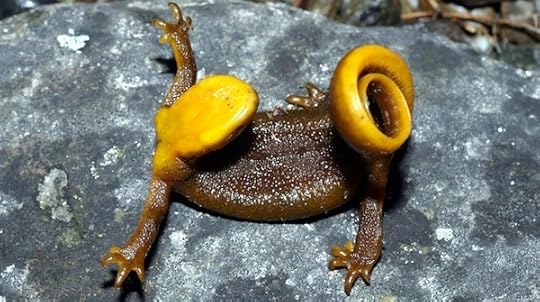 I just got back yesterday from the annual meeting of the Society for the Study of Evolution. It took place in a big hotel on the outskirts of Norman, Oklahoma, during a windy heat wave that felt like the Hair Dryer of the Gods. It had been a few years since I had last been to an SSE meeting, and I was struck by how genomic everything has gotten. No matter how obscure the species scientists are studying, they seem to have outrageous heaps of DNA sequence to analyze. A few years ago, they would have been content with a few scraps. Fortunately, SSE hasn't turned its back on good old natural history. There were lots of fascinating discoveries on offer, about species that I had assumed had been studied to death. My favorite was a talk about the rough-skinned newt, the most ridiculously poisonous animal in America.
I just got back yesterday from the annual meeting of the Society for the Study of Evolution. It took place in a big hotel on the outskirts of Norman, Oklahoma, during a windy heat wave that felt like the Hair Dryer of the Gods. It had been a few years since I had last been to an SSE meeting, and I was struck by how genomic everything has gotten. No matter how obscure the species scientists are studying, they seem to have outrageous heaps of DNA sequence to analyze. A few years ago, they would have been content with a few scraps. Fortunately, SSE hasn't turned its back on good old natural history. There were lots of fascinating discoveries on offer, about species that I had assumed had been studied to death. My favorite was a talk about the rough-skinned newt, the most ridiculously poisonous animal in America.
The scientific tale of the rough-skinned newt begins five decades ago, with a story about three dead hunters in Oregon. Reportedly, the bodies of the hunters were discovered around a camp fire. They showed no signs of injury, and nothing had ...
June 18, 2011
My "Viral Time" talk–now on FORA.tv
Here, for your viewing pleasure (I hope), is my recent talk about time and viruses, at the Long Now Foundation. I turn up after a short video, and then after the lecture Stewart Brand and I have a fun conversation about how viruses will not infect you with superpowers.

My viral book review for the Wall Street Journal
The Wall Street Journal asked me to review another book. This time around it's Virolution, by Frank Ryan. It's about a lot of things that I'm pretty crazy about (like the viruses that make up a lot of our genome). But I wasn't crazy about the book itself, I'm afraid. Still, the review was a good opportunity to talk about what our inner viruses may mean for our well-being. Check it out.

June 17, 2011
Fighting the Pain: My new column for Discover
Pain is a paradox. It feels like the most real, objective experience we can have, and yet it can be weirdly malleable. It's better to think of pain, like memory or vision, not as a simple reflection of the world, but as a strategy we've evolved to stay alive. Thinking this way can help make sense of the awful experience of chronic pain, when this urgent signal refers to nothing except a brain caught in its own feedback loops. In my latest column for Discover, I take a look at the latest understanding of pain, and some promising research that uses these insights to search for a new, more rational pain-killer. Check it out.
[Image: Boy With A Rooster by Adriano Cecioni, 1868 . Photo from Kate Eliot/Flickr via Creative Commons License ]

June 16, 2011
Listen live to some virus talk at 2 pm EST today on KERA/Dallas
I'll be on "Think," an hour-long talk show on Dallas's public radio station KERA at 2 pm EST, to talk about A Planet of Viruses. Listen live here.










